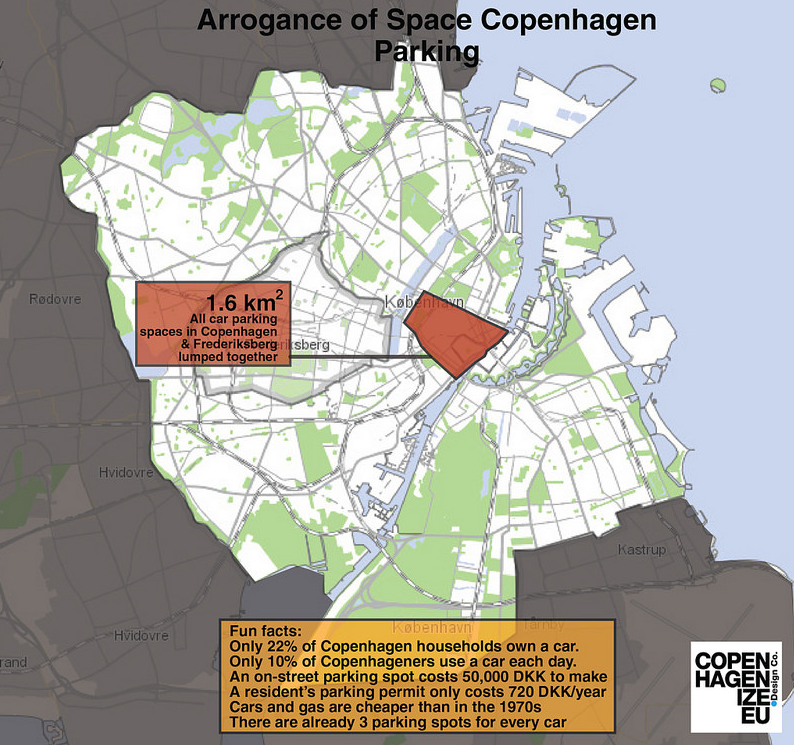Giving "parking crater" a new meaning: All 18.6 million parking spots in LA County would take up enough space to create a parking lot 16 miles in diameter, obliterating a huge number of the communities and institutions that make LA such an attractive place to live, work, and visit. Even spread throughout the region, these parking spaces extend the distances between our destinations, raise prices and housing costs, and discourage healthier forms of transportation like walking and biking.
A new study in the Journal of the American Planning Association estimates that in 2010 there were approximately 18.6 million parking spaces in Los Angeles County. That's about 3.3 spaces, or 1,000 square feet, per vehicle—literally more space for each car than for each person in the county. The authors also note that the amount of parking has continued to grow over the years, from around 2.5 million spaces in 1930, to 12 million in 1970, to 18.6 million in 2010. That data is over 5 years old, so don't be surprised if we're approaching the 19 million mark by now.
Click for larger version of image.
Around the same time this study was released, Copenhagenize wrote an unrelated article titled "The Arrogance of Parking Space," which looked at the amount of space taken up by parking to serve the relatively small number of Copenhagen residents that own vehicles. (Only about 22% of households own cars there.) It included a striking map, showing that if every parking space in the region were put together into a single surface parking lot it would completely obliterate the city center. Parking is distributed throughout the region, so its effects can be difficult to perceive at a macro level; putting all those spaces side-by-side really helps to illustrate just how much space is devoted to the non-productive storage of vehicles.
And while far more people drive and own cars in LA than in Copenhagen, I thought we could use some similar perspective. So like Copenhagenize, I made a map that shows how much space parking takes up in LA County, and like Copenhagenize, it was shocking. To estimate the amount of parking space, I assumed that each parking stall would require about 300 square feet of space, including the access and circulation area needed for cars to get around any parking lot. At 300 square feet per parking space, those 18.6 million LA County spaces would take up approximately 200 square miles. (Authors of the American Planning Association article came to the same conclusion.) Here's about what that would look like:
If all the parking in LA were one big, red surface parking lot, it would measure 16 miles in diameter, reaching from East LA to Santa Monica
In short, the amount of parking in LA County gives the term "parking crater" a whole new meaning. This imaginary parking lot, which is 16 miles in diameter, is enough to completely wipe out downtown LA, Boyle Heights, Chinatown, Koreatown, Westlake, Glassel Park, Silver Lake, and Echo Park; most of South LA; Hollywood, West Hollywood, and Beverly Hills; Mid-Wilshire; Culver City; most of the Westside; and all of USC, UCLA, and Griffith Park. Rather than getting you from Downtown to Santa Monica, the 10 would get you from one end of the parking lot to the other. On the bright side, there would be plenty of parking for the beach, LAX, and the Rose Bowl Parade—though walking from the lot might take you a few hours.
No one's arguing that all 18.6 million parking spaces in Los Angeles are a waste; there's an obvious need for parking, and for the automobiles that require it, in a variety of circumstances. But put together, this 200 square mile area is home to about 2.3 million people, 900,000 homes, and near one million employees. And without so much parking it could be home to many more, at a time when our region is struggling with an unprecedented housing shortage, booming population, and a strong economy. As driverless cars and other transportation technologies evolve over the coming decades, and mass car ownership continues to erode, the limited value—and wasted opportunity—of these millions of parking spaces will become increasingly obvious.
Total parking spaces in LA County over time. Chart from JAPA article by Mikhail Chester, et al.
It can be hard to grasp the scale of this lost opportunity when it's distributed throughout the entire region in the form of residential one- and two-space garages, on-street parking, and underground, podium, and surface parking lots. It's there, though. When we look at it all put together, side by side, it's clear how much we've given up to make space for cars—to say nothing of the roads and highways that complement these parking spaces. Because of our focus on parking, the distance between people and their destinations is greater, so they spend more time in traffic or on the bus; parking is baked into the price of most housing, goods, and services, so we pay more for all of them (hundreds of dollars per month, at least); and since we've built our city around the assumption that most people will drive, most people do—because all the incentives point in that direction. And as the authors of the study note, our land use policies continue to produce more and more parking throughout the county, wasting valuable space that could be bringing people closer to their daily destinations and saving them thousands of dollars every year. There is something seriously, seriously wrong with a system where we require more space for every car than for every person.
